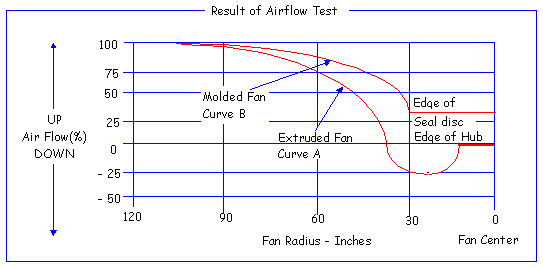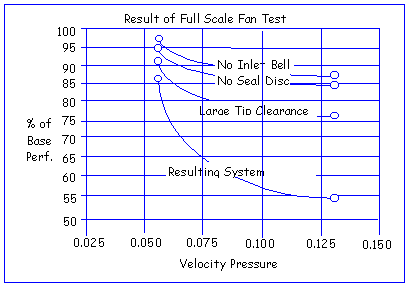|
|
|
|
|
S.P. act. (inch Aq.) x Airflow(ft3/min)
T.P. act. (inch Aq.) x Airflow(ft3/min) Where, HP act. = Actual break
horsepower obtained from performance curve. The Hudson fan performance curves are the result of tests run in accordance with Fig. 13 of Standard 210-74 "Laboratory Methods of Testing Fans for Rating" adopted by AMCA (Air Moving and Conditioning Association, Inc.) The test conditions to obtain performance curves is attached hereafter. Actual fan efficiencies will be different from the test conditions unless the actual environment is equivalent to the test conditions. There are some factors to rob the fan system of efficiency. The methods how to improve them shall be suggested here. 1) Fan System Efficiency When we design an air moving device one of the most important tools we use is the fan performance curve. Using this curve of fan performance we plot a system resistance line to establish an operating point at which the fan performance exactly matches the system requirements. From the operating point we can define the fan pitch and power requirements. With almost any fans the pitch can be changed from the original estimate, if airflow is too low, to a higher pitch and greater flow. However, if the system efficiency or losses are not as assumed, more air, horsepower increases by the cube of the flow is needed. A ten percent increase in flow requires a thirty-three [HP2 = (Q2 / Q1)3 x HP1 = 1.13 HP1 = 1.331 x HP1, so 33.1% increase to HP1) percent increase in horsepower. Fan performance curves generally are obtained under ideal, reproducible conditions. The Engineering Test Lab at Texas A&M's Research and Extension Center is the only independent test laboratory in U.S.A. with an AMCA certified wind tunnel. The lab tests everything from kitchen ventilators to scale model 60 feet diameter fans. The test conditions for high performance axial fans usually require blade tip clearance on a five foot model of about 0.04 of an inch with a large inlet bell conditions as ideal as possible. As a result of good aerodynamic design and minimized losses, total efficiencies are generally in the 75 to 85% range. However, from experience with many full scale fan tests it is rare that "real life" performance exceeds 55 to 75% total efficiency. The difference is in "Fan System Efficiency". Although the fan efficiency is exactly same, the system efficiency is greatly different. Sometimes we find its capability is sadly insufficient, requiring expensive field modifications. What most likely caused the problem? Generally, tip losses, reverse flow at the fan hub and recirculation loss as below figure.
To refresh your memory as to terminology, the head or total pressure that an axial fan works against is made up of two components. These are static pressure which is the sum of the system resistance and velocity pressure which is a loss associated with accelerating the surrounding air from zero to the design velocity. The only useful work done is by the static pressure component. That is measured in inches of water and an axial fan normally works in the range of 0 to 2 inches total pressure. 2) System Losses The holes in the Bucket. Potential losses in system efficiency occurs in several areas: (A) Losses caused by the fixed system design rather than by variable physical properties. Once the operating point of the fan is fixed these losses are built-in and cannot be easily detected or corrected. They are losses because they rob the system of potential efficiency. Examples of this type of system "loss" would be: choice of fan design, fan diameter selection, fan design operating point. (B) Losses caused by "variable environmental properties" would be: lack of fan hub seals, excessive fan tip clearance, poor inlet conditions of the fan stack, excessively high approach velocity to the fan, or random air leaks in the fan plenum. Often allowance for losses in louvers, bug screens, etc. are simply omitted in design. (C) Other performance losses could occur because of hot air recirculation. Of the above losses, the only easily corrected problems would be in category which we call "variable environmental properties." In the following discussion category (A)will be covered in The Fan Itself. Category (B) will be discussed in The Fan Housing and (C) will be covered under Unwanted Air Movements respectively in below. (1) The Fan Itself: The ways a fan system could be inefficient are sometimes obvious but most of the time they are not. For instance, the blade design itself is a major factor. Modern axial fans are usually made by molding fiberglass or extruding aluminum. Extruded aluminum blades are by nature always of uniform chord width while molded fiberglass blades can have an irregular shape. One of the basic design criteria for blade design is to produce uniform air flow over the entire plane of the fan. One of the aerodynamic principles involved is that the work done at any radius along the blade is a function of blade width, angle of attack and tangential velocity squared. The "angle of attack" in airfoil design dictates the amount of blade twist required at any particular radius along the blade. It follows that as a point on the blade decreases from tip toward the hub the tangential velocity sharply decreases and in order to produce uniform airflow, the blade width and twist must be increased. If the blade chord cannot be increased in width, the twist must be increased to compensate. With an extruded blade the twist is created by mechanically yielding the blade to a prescribed degree. Due to limits in elasticity only limited twist can be created. In a molded blade there is no such limitation to chord width or twist so the ideal blade can be more closely approached. The point is, that the blade design itself can create problems of non-uniform air flow and inefficiency. Another inherent property of an axial fan is the problem of "swirl" which is the tangential deflection of the exit air direction caused by the effect of torque. The air vectors at the extreme inboard sections of the blade actually reverse direction and subtract from the net airflow. This is a very measurable quantity. Swirl can be prevented with an inexpensive hub component, which usually covers the inner 25 -30% of fan dia. The hub seal disc prevents this and should be standard equipment on any axial fan.
A real example that illustrates performance differences due to blade shape and seal disc usefulness is shown in above figure. This data was obtained by a major cooling tower manufacturer who carefully measured air flow magnitude and direction across a blade in a full scale cooling tower. Curve "A" shows the performance of an extruded aluminum straight type blade with no hub seal disc. Curve "B" shows performance of a tapered fiberglass blade with a seal disc. Both 20 feet diameter fans were tested under identical loading conditions of horsepower and speed. Note that significant negative air flow occurs at approximately the 40 percent chord point on the straight blade but no negative flow was found with the tapered blade. Another component of the fan system efficiency would have to be the fan operating point where the system resistance line meets the fan performance line at the desired air flow defines a fan? operating point. At this point, the fan? output exactly meets the air-flow and pressure-drop requirements. Such a point will be represented by only one specific blade pitch angle, actual ft3/min and total pressure air output, and fan rpm. This would be the particular blade pitch angle that produces the desired air flow against the required system resistance. This pressure capability and flow is a function of the fan tip speed. For a certain fan speed, only one pitch angle will satisfy the system design operating condition. This fan operating point will have a discrete efficiency. However, efficiency varies as much as 10 - 15 percent from pitch angle to pitch angle and even along the usable portion of each pitch. An usable portion of curve means beyond the "stall" conditions. This "stall" condition is easily discernible on the fan curve and is analogous to cavitation on a pump: it consumes a lot of energy but produces no work. The most obvious thing to check pertaining to operating point is whether the fan is "stalled". If a poorly operating fan is suspected of stall, try lowering blade pitch and see if the static pressure (measured with a water manometer) in the plenum changes. If the pressure does not change, the fan may be stalled. A stalled fan draws more horsepower with increasing pitch, but air flow and static pressure may actually decrease. To be continued. Please press the next button..... |



